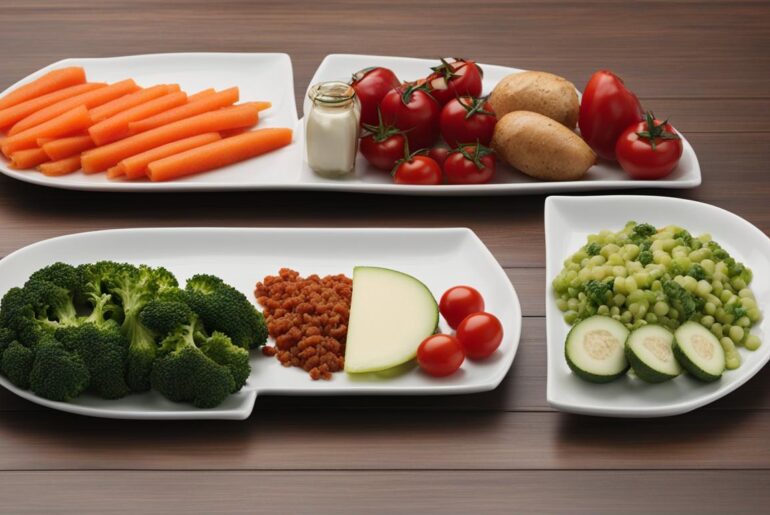Welcome to the first section of our article on mindful eating and portion size awareness. In this section, we will explore the importance of these practices in developing healthy eating habits (check this post out). By understanding how hormones, stress, sleep, and physical activity influence our eating patterns, we can make conscious choices that promote overall well-being.
Hormones, such as ghrelin and leptin, play a crucial role in signaling hunger and satiety. When these hormones are disrupted by stress, it can lead to overeating or undereating. Adequate sleep is another factor that affects our appetite, and physical activity helps regulate hormone levels and promotes a healthy lifestyle.
Key Takeaways:
- Mindful eating and portion size awareness are important for developing healthy eating habits.
- Hormones, stress, sleep, and physical activity can all influence our eating patterns.
- Ghrelin and leptin are hormones that signal hunger and satiety.
- Stress can alter these hormones and lead to overeating or undereating.
- Adequate sleep is important for managing appetite, and physical activity helps regulate hormone levels.
Factors Influencing Healthy Eating
When it comes to maintaining wellness, healthy eating plays a crucial role in promoting overall health and vitality. However, several factors can influence adolescents’ food choices, shaping their eating habits and impacting their well-being. Understanding these influences is essential in developing a balanced and nutrient-rich diet.
Influences on Food Choices
Adolescents’ food preferences and eating patterns can be influenced by various factors, including:
- Increased appetite: During periods of growth and development, adolescents often experience heightened hunger, leading to potentially unhealthy food choices.
- Peer influence: Adolescents are particularly susceptible to peer pressure, which can impact their food choices and dietary behaviors.
- Culture: Cultural norms and traditions can shape adolescents’ food preferences, determining the types of foods they consume and the frequency of certain meals.
- Family eating patterns: Family dynamics and eating habits at home greatly influence adolescents’ dietary choices, as they tend to adopt the eating patterns observed within their households.
While these influences may seem challenging, individuals can effectively navigate them by focusing on nutrient-dense foods and following evidence-based guidelines.
The Importance of Nutrient-Dense Foods
Choosing nutrient-dense foods is vital for supporting healthy eating habits. Nutrient-dense foods are rich in essential vitamins, minerals, and other beneficial compounds while being relatively low in calories. They provide the necessary sustenance our bodies need to function optimally while promoting overall well-being.
To ensure a balanced diet, it is recommended to follow the 2020-2025 Dietary Guidelines for Americans. These guidelines provide evidence-based recommendations for individuals of all ages to promote health and prevent chronic diseases.
| Nutrient Groups | Examples of Nutrient-Dense Foods |
|---|---|
| Fruits and Vegetables | Fresh berries, leafy greens, colorful vegetables |
| Protein | Lean meats, poultry, fish, beans, nuts, seeds |
| Dairy | Low-fat or fat-free milk, yogurt, cheese |
| Grains | Whole grains, such as brown rice, quinoa, whole wheat bread |
The MyPlate resource, developed by the United States Department of Agriculture, guides adolescents in making informed food choices. It emphasizes proportionality, variety, and moderation, encouraging individuals to fill their plates with a balance of fruits, vegetables, dairy, and protein.
Building Healthy Relationships with Food

Developing a healthy relationship with food is essential for overall well-being. It involves nurturing a positive mindset towards eating, embracing mindful eating practices, and cultivating intuitive eating habits. This section will explore the concepts of mindful eating and intuitive eating, emphasizing their role in promoting a healthy relationship with food and fostering a positive body image.
Mindful Eating: Nurturing Psychological Well-being
Mindful eating is a practice that encourages us to be present and fully engaged in the eating experience. By paying attention to the details of our food, such as its taste, texture, and aroma, we can cultivate a deeper connection with what nourishes our bodies. This level of awareness promotes psychological well-being by helping us become more attuned to our body’s hunger and fullness cues.
By practicing mindful eating, we can develop a greater appreciation for the food we consume and make more healthful choices. This conscious approach to eating enables us to savor each bite, leading to a more satisfying and enjoyable meal. Through mindful eating, we learn to honor our body’s needs and develop a healthier relationship with food.
Intuitive Eating: Supporting Personal Wellness
Intuitive eating is a philosophy that encourages us to rely on instinct, emotion, and rational thought when making food choices. It emphasizes tuning into our body’s internal cues, rather than external influences or societal expectations. Intuitive eating is rooted in self-care, promoting personal wellness without a focus on weight loss or restrictive eating patterns.
By practicing intuitive eating, we can foster a deeper understanding of our body’s needs and preferences. This approach empowers us to make food choices that align with our individual tastes and nourishment requirements. Intuitive eating allows us to develop a healthier relationship with food, free from guilt or shame, and promotes body acceptance and positive body image.
Reducing the Risk of Disordered Eating and Body Image Concerns
Both mindful eating and intuitive eating can significantly reduce the risk of developing disordered eating behaviors or negative body image issues. By building a healthy relationship with food, individuals are less likely to engage in restrictive diets, binge-eating episodes, or purging behaviors.
Practicing mindful and intuitive eating techniques encourages a balanced and sustainable approach to nutrition. It emphasizes self-compassion and focuses on overall well-being rather than external appearance or societal pressures. By cultivating positive body image and embracing a healthy relationship with food, individuals can find freedom from the destructive cycle of negative self-perception and disordered eating habits.
Remember, a healthy relationship with food is not about perfection but rather about developing a positive mindset, embracing mindful and intuitive practices, and learning to nurture our bodies with love and respect.
| Benefits of Building a Healthy Relationship with Food |
|---|
| Promotes psychological well-being |
| Enhances body acceptance and positive body image |
| Reduces the risk of disordered eating behaviors |
| Fosters a balanced and sustainable approach to nutrition |
| Encourages self-compassion and mindfulness |
In the next section, we will delve deeper into the concept of portion control and its significance in maintaining a healthy lifestyle.
Understanding Portion Control
When it comes to maintaining a healthy diet, portion control plays a vital role. It involves consciously consuming an appropriate amount of food to meet our nutritional needs. But what exactly is portion control, and how does it differ from portion size and serving size?
Let’s break it down:
- Portion size refers to the amount of food an individual chooses to eat. It can vary based on personal preferences, appetite, and hunger levels.
- Serving size, on the other hand, is a standardized measurement used to calculate nutritional information. It helps us understand the nutrients and calories in a particular food item.
Understanding portion control is crucial to prevent overeating and support weight management. By being aware of the portions we consume, we can ensure we are providing our bodies with the right amount of fuel without going overboard.
Visual cues and mindful eating techniques can help us practice portion control effectively. By using smaller plates and bowls, we can trick our minds into perceiving larger portions. This can lead to feeling satisfied with smaller amounts of food.
Another great tool to guide portion control is meal prepping. By planning and pre-portioning our meals, we can avoid mindless eating and maintain consistent portion sizes. This not only helps eliminate the temptation to overeat but also promotes healthier food choices.
Now, let’s take a look at a comprehensive table that highlights the difference between portion size and serving size:
| Portion Size | Serving Size |
|---|---|
| Amount of food an individual chooses to eat | Standardized measurement used to calculate nutritional information |
| Varies based on personal preferences and appetite | Consistent for a specific food item |
| Can be modified depending on hunger levels | Provides a clear understanding of nutrients and calories |
By incorporating these strategies and understanding the difference between portion size and serving size, we can develop a healthier relationship with food and achieve our wellness goals.
Common Challenges in Portion Control

Portion control can be a struggle for many individuals, with various challenges that can hinder our efforts to maintain healthy eating habits. Understanding and addressing these challenges is essential for successful portion control and achieving our health goals.
Emotional Eating
Emotional eating refers to the tendency to eat in response to emotions rather than physical hunger. Common emotions that can trigger emotional eating include stress, boredom, sadness, and anxiety. When faced with these emotions, individuals often turn to food as a form of comfort or distraction, leading to overeating and difficulty in controlling portion sizes.
Mindless Eating
Mindless eating occurs when we consume food without paying attention to portion sizes or being fully aware of what and how much we are eating. This can happen when we eat while distracted, such as watching television or working on the computer, and can result in consuming larger portions than we need. Mindless eating can also be influenced by external cues, such as the size of the plate or package, leading to overeating due to a distorted perception of appropriate portions.
Social and Environmental Influences
Social and environmental factors play a significant role in our portion control challenges. In social settings, such as restaurants or gatherings, we may be influenced by the portion sizes served or the eating habits of those around us. Large portion sizes commonly found in restaurants and all-you-can-eat buffets can distort our perceptions of what constitutes an appropriate portion. Additionally, environmental cues, such as the availability and accessibility of unhealthy food options, can make it difficult to make mindful choices and control portion sizes.
To overcome these challenges, it is crucial to identify the triggers that lead to emotional eating, practice portion awareness, and create a supportive environment that promotes healthy eating habits. Developing strategies to manage emotional triggers, such as engaging in stress-relieving activities or finding alternative ways to cope with boredom, can help minimize emotional eating tendencies. Practicing mindful eating, which involves paying attention to the sensory experience of food and being present in the moment, can help prevent mindless eating and promote portion control.
An effective way to combat social and environmental influences is by planning ahead and making conscious choices. Prioritize healthier food options and portion sizes when dining out and consider sharing a meal or taking leftovers home to avoid overeating. Creating a supportive environment at home by keeping healthy snacks readily available and removing temptations can also aid in portion control efforts.
| Challenges | Strategies |
|---|---|
| Emotional Eating | Identify emotional triggers and find alternative coping mechanisms. |
| Mindless Eating | Practice mindful eating and eliminate distractions during meals. |
| Social and Environmental Influences | Plan ahead, prioritize healthier options, and create a supportive environment. |
Awareness of these common challenges and implementing effective strategies will empower individuals to take control of their eating habits and achieve portion control. By overcoming emotional eating, practicing mindful eating, and navigating social and environmental influences, we can establish a healthy relationship with food and maintain balanced portion sizes for optimal health and well-being.
Effective Strategies for Portion Control
Implementing effective strategies is crucial for mastering portion control and maintaining a healthier lifestyle (check out my post on mastering portion control here). By incorporating mindful eating techniques, pre-portioning meals, practicing meal planning, and understanding portion sizes, you can take control of your eating habits and make informed choices.
Mindful Eating Techniques
Mindful eating involves being present and fully engaged in the act of eating. By focusing on the sensory experience of each bite, you can enhance portion control. Try eating slowly, savoring each mouthful, and paying attention to feelings of hunger and fullness. Using smaller plates and bowls can also trick your mind into perceiving larger portions and promote portion control.
Pre-Portioning
Pre-portioning meals and snacks is an effective way to manage portion sizes and prevent overeating. By dividing meals into individual servings in advance, you can ensure that you consume an appropriate amount of food. Pre-portioning also saves time and makes it easier to make healthier choices when hunger strikes.
Meal Planning
Meal planning is a valuable tool for portion control as it allows you to anticipate your nutritional needs and make mindful decisions about portion sizes. By planning your meals in advance, you can ensure that your plate is filled with a balanced variety of nutrient-dense foods. Meal planning also helps eliminate the temptation of oversized or unhealthy options when hunger strikes.
Understanding Portion Sizes
Having a clear understanding of portion sizes is essential for portion control. Visual cues such as using your hand or everyday objects as reference points can help you estimate portion sizes. Familiarize yourself with nutritional information labels and serving size recommendations to make informed decisions about the amount of food you consume. By knowing the appropriate portion sizes, you can avoid unnecessary overeating.
Implementing these strategies into your daily life can significantly enhance your portion control efforts. Mindful eating techniques, pre-portioning meals and snacks, meal planning, and understanding portion sizes empower you to make informed choices and maintain balance in your diet. With practice and dedication, you can master portion control and enjoy a healthier relationship with food (see my post here).
Tracking Progress and Staying Motivated

When it comes to portion control, tracking your progress and staying motivated are crucial. By implementing effective strategies and seeking support, you can achieve long-term success and maintain a healthy lifestyle.
One effective way to track your progress is by keeping a food diary or using mobile apps specifically designed for food tracking. These tools not only raise your awareness of portion sizes but also help identify areas for improvement. By visually seeing what you consume, you can make adjustments and ensure you’re sticking to your portion control goals.
Another important aspect of staying motivated is celebrating small victories and achievements along the way. By acknowledging your progress, such as consistently following portion control guidelines or reaching certain milestones, you can maintain a positive mindset and stay focused on your goals.
“Progress is progress, no matter how small. Celebrate every step you take towards healthier portion sizes.”
Seeking support from friends, family, or support groups with similar health goals can provide valuable encouragement and accountability. By sharing your journey with others, you can find motivation, exchange tips and strategies, and overcome challenges together.
Consistency and dedication are key to long-term success with portion control. It’s important to remind yourself of the benefits and stay committed to your goals. Remember that progress takes time, and every effort you make towards portion control is a step in the right direction.
Benefits of Tracking Progress and Staying Motivated:
- Increases awareness of portion sizes
- Identifies areas for improvement
- Ensures adherence to portion control goals
- Maintains a positive mindset
- Provides encouragement and accountability
- Builds a supportive community
- Strengthens dedication and consistency
- Achieves long-term success in portion control
Conclusion
Mastery of mindful eating and portion size awareness brings numerous benefits, including improved physical and psychological well-being. By understanding portion control, overcoming common challenges, and implementing effective strategies, individuals can take control of their eating habits and achieve a healthier lifestyle. With conscious choices and awareness of portion sizes, balanced nutrition and health goals can be accomplished.
Portion size awareness benefits individuals in various ways. It helps prevent overeating and promotes weight management, reducing the risk of obesity and related health conditions. By practicing portion control, individuals can nourish their bodies with the right amount of nutrients, supporting overall health and well-being.
Incorporating portion size awareness into daily life is crucial for maintaining a healthier lifestyle. It enables individuals to make informed decisions about their food choices, ensuring a balanced diet that includes the right proportion of carbohydrates, proteins, healthy fats, vitamins, and minerals. By prioritizing portion control and mindful eating, individuals can develop sustainable habits that promote long-term health and wellness.
Embracing portion size awareness is a powerful tool on the journey to a healthier lifestyle. By mastering portion control, individuals can overcome challenges such as emotional eating, mindless snacking, and societal influences that encourage excessive portion sizes. Through consistent practice, individuals can establish a positive relationship with food and gain a sense of empowerment in their dietary choices.




